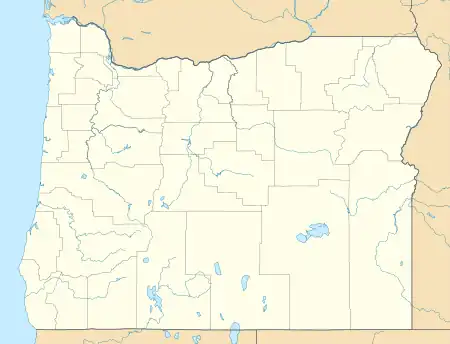Cottonwood Canyon State Park
Cottonwood Canyon State Park, established in 2013, is the second largest state park in Oregon, encompassing 8,000 acres (3,200 ha) on the lower John Day River.[1] The largest is Silver Falls State Park at 9,064 acres (3,668 ha).[1]
| Cottonwood Canyon State Park | |
|---|---|
 Information station in the park | |
  | |
| Type | Public, state |
| Location | Sherman and Gilliam counties, Oregon |
| Nearest city | Wasco |
| Coordinates | 45°28′42″N 120°28′20″W |
| Area | 8,000 acres (3,200 ha) |
| Created | 2013 |
| Operated by | Oregon Parks and Recreation Department |
| Open | All year |
| Website | Cottonwood Canyon State Park |
Park headquarters, about a two-hour drive east of Portland, is adjacent to Oregon Route 206 between Wasco and Condon.[1] The river, which here forms the boundary between Sherman County on the west and Gilliam County on the east, meanders for 16 miles (26 km) through the arid park.[2]
The walls of the main canyon reach to 1,920 feet (590 m) above sea level within the park, which also includes four side canyons: Hay Creek, Esau, Rattlesnake, and Cottonwood. These and the main canyon are flanked by grassland, sagebrush shrub-steppe, river bottom, and cliffs composed mainly of basalts of the Columbia River Basalt Group.[2]
History
In 2008, the Western Rivers Conservancy, a non-profit organization based in Portland, bought the land from a cattle-ranching family, the Murthas, who had owned it since the 1930s. The conservancy was able to borrow money from the Wyss Foundation to make a quick purchase possible. Later, Western Rivers offered to sell the land to the Oregon Parks and Recreation Department (OPRD) to create a state park. OPRD agreed and paid Western Rivers what the non-profit had paid the Murthas, $7.86 million.[1] In 2022, the park applied to become the 2nd IDA Dark Sky Park in the state of Oregon, with approvals expected to come by mid to late 2023.[3]
Recreation
Hiking, camping, fishing, and river rafting are among the recreation possibilities in the park. A campground with 21 primitive sites, 7 sites for hikers and bikers, a group camping area, potable water, and a restroom are near the park headquarters and the information building.[2] Hiking trails include Pinnacles, in Sherman County, and Lost Corral, in Gilliam County, each of which follows the river downstream for 4.3 miles (6.9 km).[4] On the upstream side of the highway, the Hard Stone Trail follows the river for 1.5 miles (2.4 km).[4] In addition, old ranching roads that cross the park double as hiking trails, and an adjacent 10,000 acres (4,000 ha) of public land managed by the U.S. Bureau of Land Management offer further possibilities for hiking.[4]
Horse trails wind through the Gilliam County segment of the park.[2] The J. S. Burres day-use area, also in the Gilliam County segment, is a put-in place for boaters heading downriver and a take-out place for commercial and private groups running the John Day between Clarno and Route 206.[2] Hunting, subject to Oregon Department of Fish and Wildlife regulations, is allowed in undeveloped parts of the park.[2]
Cottonwood Canyon is also one of the darkest state parks in Oregon, which makes the park ideal for star gazing.[5] The canyon provides an opportunity to stargaze that is hidden from lights from the surrounding areas and adjacent road.
Fauna and flora
In 2010, a small number of California bighorn sheep were transplanted to the park's future location from the nearby Lower Deschutes Wildlife Area;[6][7] the herd eventually grew into one of Oregon's largest.[8] Rocky Mountain elk, mule deer, pronghorn, coyotes, and many smaller mammals can be found in the area. A variety of snakes (including the western rattlesnake) live in the park, which is also home to several lizard species. Frogs, toads, and waterfowl can be found near the river.[2] Fish in the river include Chinook salmon, steelhead, catfish, carp and smallmouth bass.[4]
Raptors such as American kestrels and Swainson's hawks frequent the area. Game birds such as the chukar partridge and the ring-necked pheasant are found in the uplands, and migratory birds such as Bullock's oriole and the lazuli bunting visit the park in summer.[2]
Balsamroot and monkey flower bloom here in early May. Sagebrush blooms in October.[2] OPRD workers have been planting small numbers of box elder, chokecherry and hawthorn trees to provide shade near park headquarters.[1]
See also
References
- Richard, Terry (September 23, 2013). "Cottonwood Canyon Opens as Oregon's Second-Largest State Park, Thanks to Western Rivers Conservancy". Oregon Live. Advance Digital. Retrieved October 10, 2013.
- "Cottonwood Canyon State Park" (PDF). Oregon Parks and Recreation Department. July 2013. Retrieved October 10, 2013.
- R, Mike (February 2, 2023). "Interesting Dark Sky Observations About the Pacific Northwest". CosmosPNW. Retrieved February 4, 2023.
- "Cottonwood Canyon State Park". Oregon Parks and Recreation Department. 2013. Retrieved October 10, 2013.
- R, Mike (October 4, 2021). "Ideal Oregon IDA Dark Sky Site Candidates". CosmosPNW. Retrieved January 15, 2022.
- "Bighorn sheep released at new Oregon locations". Oregon Department of Fish and Wildlife. December 17, 2010.
- Richard, Terry (December 17, 2010). "Bighorn sheep transplanted into future Cottonwood Canyon State Park". OregonLive.com. The Oregonian. Retrieved February 3, 2023.
- Tschanz, Skip (October 26, 2013). "Skip's Trailhead: Cottonwood Canyon". Columbia Gorge News. Retrieved February 3, 2023.
